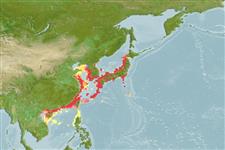>
Acropomatiformes (Oceanic basses) >
Lateolabracidae (Asian seaperches)
Etymology: Lateolabrax: Greek, latos, a fish of the Nile + Greek, labrax, -akos = a fish (Dicentrarchus labrax) (Ref. 45335).
More on author: Cuvier.
Issue
Junior synonym Lateolabrax maculatus considered as a valid species reported to be widely distributed (Japan, only in the Ariake Sea and off Nagasaki; China (off all coasts), Taiwan, and Korea (usually off the southern and western coasts) (Ref. 118669)
Environment: milieu / climate zone / depth range / distribution range
Ecología
marino; agua dulce; salobre asociado a arrecife; catadromo (Ref. 51243); rango de profundidad 5 - ? m. Subtropical; 44°N - 15°N, 106°E - 143°E
Western Pacific: Japan to the South China Sea.
Length at first maturity / Tamaño / Peso / Age
Maturity: Lm ?, range 50 - ? cm
Max length : 102 cm TL macho / no sexado; (Ref. 40637); common length : 16.1 cm SL macho / no sexado; (Ref. 35840); peso máximo publicado: 8.7 kg (Ref. 40637)
Short description
Claves de identificación | Morfología | Morfometría
Espinas dorsales (total) : 12 - 15; Radios blandos dorsales (total) : 12 - 14; Espinas anales: 3; Radios blandos anales: 7 - 9.
Found in moving water of inshore rocky reefs. Juveniles may ascend rivers and return to sea to spawn. Protandrous, sex change happens after maturation at age 2 (Ref. 36558). Spawning occurs during winter, in deeper rocky reefs or inshore areas. Predaceous, feeding on zooplankton at an early age and on small fish and shrimps as adults (Ref. 12497). Utilized as a food fish (Ref. 559). Family placement uncertain (Ref. 1830). Used in Chinese medicine (Ref. 12166).
Males mature at age 2 years, becoming females when older (Ref. 36558). Juveniles may ascend rivers migrating to the sea to spawn (Ref. 36558).
Paxton, J.R., D.F. Hoese, G.R. Allen and J.E. Hanley, 1989. Pisces. Petromyzontidae to Carangidae. Zoological Catalogue of Australia, Vol. 7. Australian Government Publishing Service, Canberra, 665 p. (Ref. 7300)
IUCN Red List Status (Ref. 130435)
Threat to humans
Harmless
Human uses
Pesquerías: comercial; Acuicultura: comercial; pesca deportiva: si
Herramientas
Special reports
Download XML
Fuentes de Internet
Estimates based on models
Preferred temperature (Ref.
123201): 12.7 - 26.3, mean 22.4 °C (based on 180 cells).
Phylogenetic diversity index (Ref.
82804): PD
50 = 1.0000 [Uniqueness, from 0.5 = low to 2.0 = high].
Bayesian length-weight: a=0.01259 (0.00885 - 0.01792), b=3.02 (2.92 - 3.12), in cm total length, based on LWR estimates for this species (Ref.
93245).
Nivel trófico (Ref.
69278): 3.1 ±0.3 se; based on diet studies.
Resiliencia (Ref.
120179): Medio, población duplicada en un tiempo mínimo de 1.4-4.4 años (K=0.14-0.2; tm=2; Fec=1,726,242).
Fishing Vulnerability (Ref.
59153): Moderate to high vulnerability (52 of 100).
Climate Vulnerability (Ref.
125649): Moderate to high vulnerability (54 of 100).
Nutrients (Ref.
124155): Calcium = 16.5 [8.1, 32.0] mg/100g; Iron = 0.471 [0.277, 0.738] mg/100g; Protein = 20.1 [19.0, 21.0] %; Omega3 = 0.212 [0.131, 0.340] g/100g; Selenium = 24.4 [12.4, 44.2] μg/100g; VitaminA = 24.7 [8.1, 76.3] μg/100g; Zinc = 0.756 [0.525, 1.096] mg/100g (wet weight); based on
nutrient studies.
